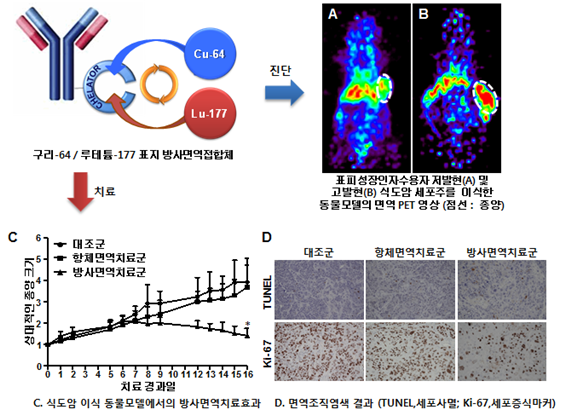글로벌 연구동향
핵의학
![[J Nucl Med.] Immuno-PET Imaging and Radioimmunotherapy of 64Cu-/177Lu-Labeled Anti-EGFR Antibody in Esophageal Squamous Cell Carcinoma Model.](/enewspaper/upimages/admin_20160810112701_R.png) [J Nucl Med.] Immuno-PET Imaging and Radioimmunotherapy of 64Cu-/177Lu-Labeled Anti-EGFR Antibody in Esophageal Squamous Cell Carcinoma Model.
[J Nucl Med.] Immuno-PET Imaging and Radioimmunotherapy of 64Cu-/177Lu-Labeled Anti-EGFR Antibody in Esophageal Squamous Cell Carcinoma Model.KIRAMS / 송인호, 이태섭*
- 출처
- J Nucl Med.
- 등재일
- 2016 Jul
- 저널이슈번호
- 57(7):1105-11. doi: 10.2967/jnumed.115.167155. Epub 2016 Feb 25.
- 내용

본 연구에서 PET용 방사성동위원소인 Cu-64를 이용하여 식도암 모델에서 면역 PET 영상을 얻었으며 종양 항원 발현을 정량적으로 평가할 수 있음을 확인하였고, 치료용 방사성동위원소인 Lu-177을 이용하여 방사면역치료를 수행하여 식도암의 성장을 효율적으로 억제함을 확인한 연구이다.
Abstract
Immuno-PET provides valuable information about tumor location, phenotype, susceptibility to therapy, and treatment response, especially to targeted radioimmunotherapy. In this study, we prepared antiepidermal growth factor receptor (EGFR) antibody via identical chelator, 3,6,9,15-tetraazabicyclo[9.3.1]-pentadeca-1(15),11,13-trience-3,6,9,-triacetic acid (PCTA), labeled with (64)Cu or (177)Lu to evaluate the EGFR expression levels using immuno-PET and the feasibility of radioimmunotherapy in an esophageal squamous cell carcinoma (ESCC) model.
METHODS:
Cetuximab was conjugated with p-SCN-Bn-PCTA and radiolabeled with (64)Cu or (177)Lu. In vitro EGFR expression levels were determined and compared using flow cytometry and cell binding assay. In vivo EGFR expression levels were evaluated via immuno-PET imaging of (64)Cu-cetuximab and biodistribution analysis. Micro-SPECT/CT imaging, biodistribution, and radioimmunotherapy studies of (177)Lu-cetuximab were performed in the ESCC model. Therapeutic responses were monitored using (18)F-FDG PET and immunohistochemical staining.
RESULTS:
(64)Cu- or (177)Lu-labeled antibodies showed high radiolabeling yield (>98%), stability (>90%), and favorable immunoreactivity. In vitro EGFR status measured by cell binding assay was correlated with the flow cytometry data. Immuno-PET, micro-SPECT/CT, and biodistribution demonstrated specific uptake in ESCC tumors depending on the EGFR expression levels. Tumor accumulation of (64)Cu- and (177)Lu-cetuximab was peaked at 48 and 120 h, respectively. Radioimmunotherapy with (177)Lu-cetuximab showed significant inhibition of tumor growth (P < 0.01) and marked reduction of (18)F-FDG SUV compared with that of control (P < 0.05). Terminal deoxynucleotidyl transferase dUTP nick-end labeling positivity and Ki-67 staining indices increased and decreased, respectively, in the radioimmunotherapy group compared with other groups (P < 0.01).
CONCLUSION:
(64)Cu-cetuximab immuno-PET represented EGFR expression levels in ESCC tumors, and (177)Lu-cetuximab radioimmunotherapy effectively inhibited the tumor growth. The diagnostic and therapeutic convergence radiopharmaceutical (64)Cu-/(177)Lu-PCTA-cetuximab may be useful as a diagnostic tool in patient selection and a potent radioimmunotherapy agent in EGFR-positive ESCC tumors.
Author information
Song IH1, Lee TS2, Park YS3, Lee JS4, Lee BC5, Moon BS5, An GI6, Lee HW7, Kim KI6, Lee YJ6, Kang JH6, Lim SM8.
1Molecular Imaging Research Center, Korea Institute of Radiological and Medical Sciences (KIRAMS), Seoul, South Korea Department of Biomedical Laboratory Science, Yonsei University, Wonju, South Korea.
2Molecular Imaging Research Center, Korea Institute of Radiological and Medical Sciences (KIRAMS), Seoul, South Korea nobelcow@kirams.re.kr.
3Department of Biomedical Laboratory Science, Yonsei University, Wonju, South Korea.
4Department of Anatomy, Yonsei University Wonju Collage of Medicine, Wonju, South Korea.
5Department of Nuclear Medicine, Seoul National University Bundang Hospital, Seoul National University College of Medicine, Seongnam, South Korea.
6Molecular Imaging Research Center, Korea Institute of Radiological and Medical Sciences (KIRAMS), Seoul, South Korea.
7Department of Thoracic Surgery, KIRAMS, Seoul, South Korea; and.
8Molecular Imaging Research Center, Korea Institute of Radiological and Medical Sciences (KIRAMS), Seoul, South Korea Department of Nuclear Medicine, KIRAMS, Seoul, South Korea.
- 키워드
- 177Lu; 64Cu; cetuximab; immuno-PET; radioimmunotherapy
- 연구소개
- 동아시아의 식도암은 편평상피세포암이 주류를 이루고 있어 서구 유럽의 선암과는 대별된다. 식도암에 대한 효율적인 치료법이 많이 부족한 상태에서 표적 치료법의 하나로서 종양 표적 항원의 효율적인 영상 평가를 면역PET(쳐-64)으로 하여 수행하고, 치료용 방사성동위원소(Lu-177)가 표지된 동일한 항체를 이용한 진단/치료가 가능한 컨버전스 방사성의약품을 제작하고 평가한 연구이다.
- 덧글달기
- 이전글 [J Nucl Med.] Prediction of PSA Progression in Castration-Resistant Prostate Cancer Based on Treatment-Associated Change in Tumor Burden Quantified by 18F-Fluorocholine PET/CT
- 다음글 [Eur J Nucl Med Mol Imaging.] Intratumoral heterogeneity of (18)F-FDG uptake predicts survival in patients with pancreatic ductal adenocarcinoma.









